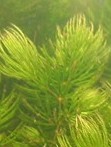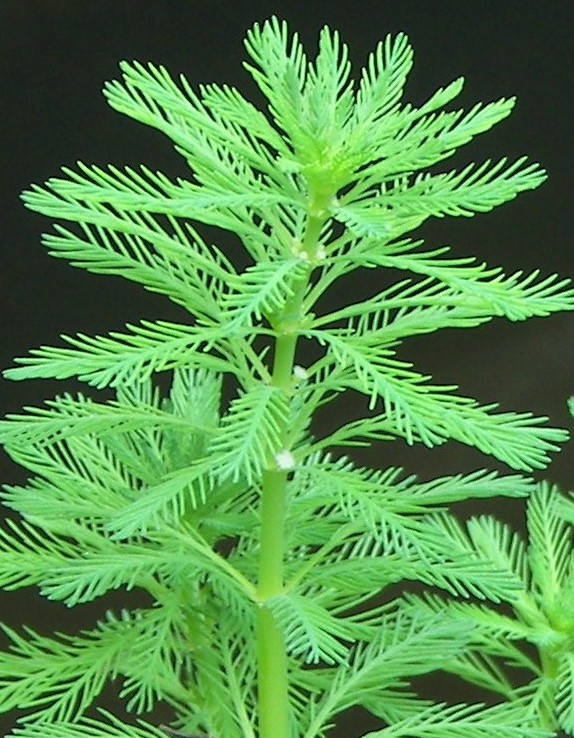 Call them oxygenators or submerged, these plants are essential for the good health of a pond especially if you have fish. Typically, they are rooted in pea gravel or the bottom soil and grow below to the surface of the water. During a sunny day they carry out photosynthesis using carbon dioxide and releasing oxygen as a result. They also take up phosphate and nitrate that cause algae problems so cut down the nutrients that cause algal blooms. Fish may use the oxygneators for reproduction and protection from predators. Oxygenators are usually sold in bunches and should be planted in a pond at the rate of one bunch per two square feet of water surface area. If fish are in the pond, plant bunches in cages so the fish don’t graze on the plants. Please note: Some states have restrictions on plants that threaten the natural ecosystems. Find out about your state’s restrictions before purchasing plants.
Call them oxygenators or submerged, these plants are essential for the good health of a pond especially if you have fish. Typically, they are rooted in pea gravel or the bottom soil and grow below to the surface of the water. During a sunny day they carry out photosynthesis using carbon dioxide and releasing oxygen as a result. They also take up phosphate and nitrate that cause algae problems so cut down the nutrients that cause algal blooms. Fish may use the oxygneators for reproduction and protection from predators. Oxygenators are usually sold in bunches and should be planted in a pond at the rate of one bunch per two square feet of water surface area. If fish are in the pond, plant bunches in cages so the fish don’t graze on the plants. Please note: Some states have restrictions on plants that threaten the natural ecosystems. Find out about your state’s restrictions before purchasing plants.
Here are five suggestions for oxygenators that can be purchased online.
 Anacharis (Egeria densa)
Anacharis (Egeria densa) A native of warm termperate areas of South America, Anacharis has become a problem in some areas of the United States and is restricted in some states. It is fast growing and features bushy stems bright green leaves arranged in whorls of four leaves each. Larger koi feed on Anacharis.
A native of warm termperate areas of South America, Anacharis has become a problem in some areas of the United States and is restricted in some states. It is fast growing and features bushy stems bright green leaves arranged in whorls of four leaves each. Larger koi feed on Anacharis.
-
Size: up to 72″ long
Planting Depth: 6″ to 8′
Site: Full sun to full shade
Hardiness:Zones 5-10
 Hornwort (Ceratophyllum demersum)
Hornwort (Ceratophyllum demersum) With a worldwide distribution this perennial is popular for its hardiness and adaptability. The stems are highly branched and support leaves produced in whorls of six to twelve. Each leaf is divided into segments and has several small teeth on the midrib giving the plant a gritty feel. The stems are so bushy they resemble a racoon’s tail giving rise to the common name, coontail
With a worldwide distribution this perennial is popular for its hardiness and adaptability. The stems are highly branched and support leaves produced in whorls of six to twelve. Each leaf is divided into segments and has several small teeth on the midrib giving the plant a gritty feel. The stems are so bushy they resemble a racoon’s tail giving rise to the common name, coontail
-
Size: 3-13′
Planting Depth: Up to 6′
Site: Full sun to part shade
Hardiness: Zones 3-12
 Dwarf Sagittaria (Sagittaria subulata)
Dwarf Sagittaria (Sagittaria subulata) This grass-like plant is native to South America and has narrow bright green leaves. Several varieites are available differing in height: var. pusilla (12″), var. kurziana (20″) and var. gracillima (24″). It spreads by runners and can become so dense that prunning may be necessary. It is fast growing and can be grown submerged or emerged.
This grass-like plant is native to South America and has narrow bright green leaves. Several varieites are available differing in height: var. pusilla (12″), var. kurziana (20″) and var. gracillima (24″). It spreads by runners and can become so dense that prunning may be necessary. It is fast growing and can be grown submerged or emerged.
-
Size: 12-24″
Planting Depth: 3″ to 3′
Site: Full sun to part shade
Hardiness: Zones 6-10
 Parrotfeather (Myriophyllum aquaticum)
Parrotfeather (Myriophyllum aquaticum) Although a native of the Amazon region of South America, parrotfeather has naturalized throughout the United States and has become a problem in some areas. It has both emergent and submergent stems bearing leaves and can extend twelve inches above the surface of the water and can grow up to five feet long to extend to the shore. The leaves are arranged in whorls of four to six in and have a feather-like look. Emergent leaves resemble the tips of fir trees. Plants spread through fragmentation of stems and rhizomes.
Although a native of the Amazon region of South America, parrotfeather has naturalized throughout the United States and has become a problem in some areas. It has both emergent and submergent stems bearing leaves and can extend twelve inches above the surface of the water and can grow up to five feet long to extend to the shore. The leaves are arranged in whorls of four to six in and have a feather-like look. Emergent leaves resemble the tips of fir trees. Plants spread through fragmentation of stems and rhizomes.
-
Size: Up to 6′
Planting Depth: Up to 3′
Site:Full sun to part shade
Hardiness: Zones 6-10 (plants die back to rhizomes in winter)
 Jungle Val (Vallisneria americana)
Jungle Val (Vallisneria americana) This large variety of Vallisneria american is a perennial and found in many places of the world other than America, in spite of its specific name. In some environments it forms a virtual forest in the water, bending where it hits the surface. It grows quickly and spreads by runners. An occasional haircut may be necessary.
This large variety of Vallisneria american is a perennial and found in many places of the world other than America, in spite of its specific name. In some environments it forms a virtual forest in the water, bending where it hits the surface. It grows quickly and spreads by runners. An occasional haircut may be necessary.
-
Size: Up to 5′
Planting Depth: 10-60″
Site: Full sun to shade; neutral to slightly alkaline water
Hardiness: Zones 4-6